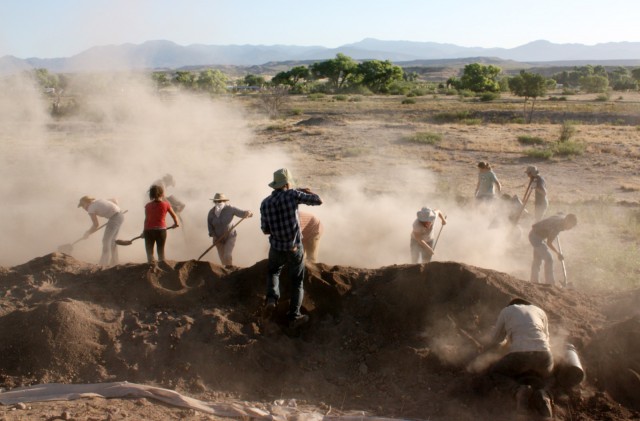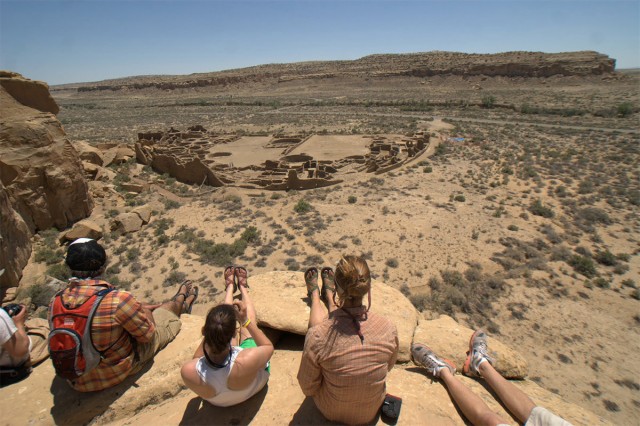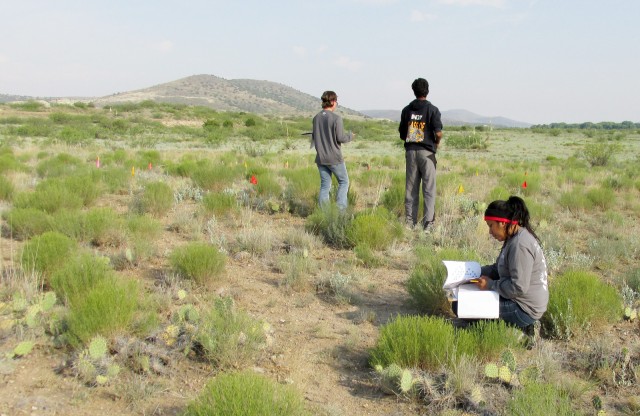- Home
- >
- Preservation Archaeology Blog
- >
- Top Ten Myths and Misconceptions about Archaeology

(October 3, 2015)—This past June, I joined Scott Michlin on the Morning Show (San Juan College KSJE) and offered my list of the Top Ten Myths and Misconceptions in Archaeology (link goes to podcast). I treated this as a fairly light-hearted exercise—certainly nothing to get too worked up over! I have personally encountered everything on the list, in one setting or another, and I know that many of my fellow archaeologists have, as well. Nevertheless, I do believe that presenting the list is a useful way to increase public understanding of the work that archaeologists do every day. I also offer some commentary on each item. I encourage folks to read this list and reply with comments or questions.
So, on to the list…in reverse order, of course:
-
- Archaeologists study dinosaurs. No, archaeologists study evidence of past people, in many different ways. Paleontologists and other geologists study dinosaurs.
![Not an archaeologist. (Photo by National Photo Company [Public domain], via Wikimedia Commons)](https://www.archaeologysouthwest.org/wp-content/uploads/2015/10/Norman_Ross_Brachyceratops_mount-sm-640x468.jpg)
-
- Archaeology is always exciting and fun. As much as I would like to believe this, no. Like any job or pursuit, archaeology has many tasks that are difficult, dirty, and sometimes less than exciting, but must be completed. If I were to rewrite this item as a positive and true statement, I would say that archaeology is always rewarding!

-
- Indiana Jones was a good (fictional) archaeologist and is a good role model for today’s archaeologists. Not. This movie character is representative of the time period in which he fictionally lived—the early part of the 20th century. Well-known archaeologist David Hurst Thomas has described this time as the “collecting” phase of American archaeology, as primarily eastern USA (and some foreign) museums built collections through a variety of highly questionable approaches. By today’s standards, Indiana Jones would be viewed as an opportunistic relic hunter with little legitimacy. As a dashing movie figure wearing a fedora, however, Dr. Jones is hard to beat!
![While skilled at maneuvering life-threatening situations, Indiana Jones is not a particularly great archaeologist by today’s standards. Illustration by Gary Stewart Gary Stewart Gary2880 (Own work) [CC BY 3.0 (http://creativecommons.org/licenses/by/3.0)], via Wikimedia Commons](https://www.archaeologysouthwest.org/wp-content/uploads/2015/03/Figure-3-1.jpg)
-
- Egypt is the only worthy destination for true archaeologists and all of us will work there, sooner or later. No. Without doubt, the archaeology of ancient Egypt is amazing. Most American archaeologists will never work in Egypt, however, and yet they find their research, whether in North America or further afield, quite stimulating and rewarding.

-
- The ancient Pueblo people (formerly called the Anasazi) disappeared from the vast Four Corners region without a trace. No, they did not. This is one of the more persistent and damaging myths we encounter. It is true that the middle territory of the ancient Pueblo landscape, the greater Four Corners region, was depopulated in the period from A.D. 1260–1300. Families and groups who emigrated did not vanish, though. Rather, they made new homes and began new lives with their friends, relatives, and other Pueblo groups to the east, along the Rio Chama and Rio Grande, to the south at the Pueblos of Zuni, Acoma, and Laguna, and to the west with the Hopi.
-
- Archaeology is primarily about digging things up, particularly human remains. No, not anymore. In the past, archaeology was much more focused on the large-scale excavation of sites. Currently, most archaeology is completed with a more balanced and nuanced approach. For example, we at Archaeology Southwest practice Preservation Archaeology—a holistic, conservation-based approach. By conducting low-impact investigations of big-picture questions, sharing our findings with our colleagues and the public, and developing powerful site protection strategies, we create meaningful connections to the past and respectfully protect its increasingly endangered resources.

-
- Archaeologists are motivated primarily by collecting the treasures, the goodies, the specimens. No, not in the present day. Again, in archaeology’s past, the focus was largely on the material objects, particularly those that were seen as rare or unusually valuable. Today, archaeology is practiced differently. Although we still appreciate the beauty and mystery of objects recovered from ancient sites, we are much more interested in understanding the people who made the objects and decoding the important processes and events that occurred in the past.
-
- Archaeology can be learned by anyone in a relatively short period of time. No, not as practiced by professionals. Professional archaeologists train as long (or longer) than professionals in other fields. Still, it is true that our field benefits from the talent and the wisdom of numerous volunteers—folks who work hard to become certified as avocational archaeologists and site stewards. It is fair to say that many archaeological projects could not be completed without these cadres of dedicated volunteers.
-
- Archaeology can be done without public support. No, it cannot. In the past, some archaeological projects were privately funded by museums or benefactors. While we continue to rely on the generous donations of private individuals, most archaeology today is publicly funded through grants from various federal and state agencies, through university-supported research, or as a result of federal laws (such as the National Historic Preservation Act) that mandate archaeological investigations prior to land-disturbing construction projects. Archaeologists rely on public support for their work and have an obligation to keep the public informed about their research.
-
- Archaeology done prior to development projects, what we describe as cultural resources management (CRM), or contract work, is primarily a jobs program. No. This is less of a myth and more of a criticism that is often leveled at those working in CRM. Since laws mandating archaeological work prior to development were implemented in the 1970s, a majority of the archaeological research completed in the U.S. has been done under the rubric of CRM.
4 thoughts on “Top Ten Myths and Misconceptions about Archaeology”
Comments are closed.
I believe without a doubt, that many exciting and important sites are never reported for different reasons. The companys that represent tunneling or excavation of construction sites have time frames to meet. The people who are likely to make contact with cultural evidence or fossils, are told by their supervision, to ignore whatever they see and focus on their job. Farmers don’t report what they see to keep strangers from interrupting their operations.Early Land levelers almost always had or have stories of uncovering interesting human habitation. Our state and federal government need to take a more active role in protecting and compensating those who need it.
Hey Paul
Always enjoy your writing–clear, concise, and on target.
Bob
What does “Your comment is awaiting moderation” mean ?
It just meant that we had to hit a button on our end!